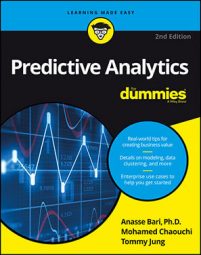Loading your data
This code listing will load theiris dataset into your session:>>> from sklearn.datasets import load_iris
>>> iris = load_iris()
Creating an instance of the classifier
The following two lines of code create an instance of the classifier. The first line imports the random forest library. The second line creates an instance of the random forest algorithm:>>> from sklearn.ensemble import RandomForestClassifier
>>> rf = RandomForestClassifier(n_estimators=15,
random_state=111)
The n_estimators parameter in the constructor is a commonly used tuning parameter for the random forest model. The value is used to build the number of trees in the forest. It's generally between 10 and 100 percent of the dataset, but it depends on the data you're using. Here, the value is set at 15, which is 10 percent of the data. Later, you will see that changing the parameter value to 150 (100 percent) produces the same results.
The n_estimators is used to tune model performance and overfitting. The greater the value, the better the performance but at the cost of overfitting. The smaller the value, the higher the chances of not overfitting but at the cost of lower performance. Also, there is a point where increasing the number will generally degrade in accuracy improvement and may dramatically increase the computational power needed. The parameter defaults to 10 if it is omitted in the constructor.
Running the training data
You'll need to split the dataset into training and test sets before you can create an instance of the random forest classifier. The following code will accomplish that task:>>> from sklearn import cross_validation
>>> X_train, X_test, y_train, y_test =
cross_validation.train_test_split(iris.data,
iris.target, test_size=0.10, random_state=111)
>>> rf = rf.fit(X_train, y_train)
- Line 1 imports the library that allows you to split the dataset into two parts.
- Line 2 calls the function from the library that splits the dataset into two parts and assigns the now-divided datasets to two pairs of variables.
- Line 3 takes the instance of the random forest classifier you just created,then calls the fit method to train the model with the training dataset.
Running the test data
In the following code, the first line feeds the test dataset to the model, then the third line displays the output:>>> predicted = rf.predict(X_test)
>>> predicted
array([0, 0, 2, 2, 2, 0, 0, 2, 2, 1, 2, 0, 1, 2, 2])
Evaluating the model
You can cross-reference the output from the prediction against they_test array. As a result, you can see that it predicted two test data points incorrectly. So the accuracy of the random forest model was 86.67 percent.Here's the code:
>>> from sklearn import metrics
>>> predicted
array([0, 0, 2, 2, 2, 0, 0, 2, 2, 1, 2, 0, 1, 2, 2])
>>> y_test
array([0, 0, 2, 2, 1, 0, 0, 2, 2, 1, 2, 0, 2, 2, 2])
>>> metrics.accuracy_score(y_test, predicted)
0.8666666666666667 # 1.0 is 100 percent accuracy
>>> predicted == y_test
array([ True, True, True, True, False, True, True,
True, True, True, True, True, False, True,
True], dtype=bool)
How does the random forest model perform if you change the n_estimators parameter to 150? It looks like it won’t make a difference for this small dataset. It produces the same result:
>>> rf = RandomForestClassifier(n_estimators=150,
random_state=111)
>>> rf = rf.fit(X_train, y_train)
>>> predicted = rf.predict(X_test)
>>> predicted
array([0, 0, 2, 2, 2, 0, 0, 2, 2, 1, 2, 0, 1, 2, 2])

